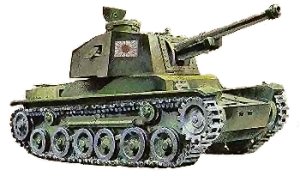Below is very interesting article about Peleliu battle.
There is not many accounts about Japanese tanks in action.
Some fragments which surprised me. Never heard about infantry in empty oil drums tied to tank… The idea is not only suicidal but crazy.
What do you think about that?
Cheers,
Lancer44
THE PELELIU TANK BATTLE
by D. Colt Denfeld
from the Sept-Dec, 1982 issue of AFV NEWS
As American forces pushed forward towards the Japanese homeland resistance in the
Central Pacific Islands intensified. The Japanese changed their tactics from a total effort
at the beach to prolonged fighting from well defended positions, such as caves in
Peleliu (Palau) and Okinawa. The invasion of Peleliu was viewed as one that would
be “short but tough”. The new Japanese tactics, combined with the terrain made it
“prolonged and tough”. The battle was supposed to last 2 or 3 days, ended up running
from Sept. 15 to Nov. 27, 1944.
American casualties were heavy, losing about 40% of the amphibious forces. The total U.S.
losses for the First Marine Division, Naval Forces, and the 81st Infantry Division (U.S. Army)
were 1,618 killed. The grip on the island on D-Day was rather shaky, and an effective
counter attack could have driven the First Marine Div. into the ocean. Instead of a well
coordinated infantry attack, the Japanese chose an armored assault. They challenged the
American M4 Shermans of the Marines with 13 Type 95 Ha-Go tanks. The Type 95 was no
match for the M4 and all 13 were quickly dispatched.
The two battles were so quickly decided that it was not clear exactly what happened, so
accounts vary greatly. The Operations Report of the 1st Marines states that at 16.15 the
Japanese sortied on the northern edge of the airfield. Seven of the 13 tanks drove across
the airfield at top speed, 40kph, hitting the American lines at about 16.50. They struck
where the 1st Marines (Regiment) and 5th Marines met. This line was about 150 meters
inland of the western invasion beaches. Some witnesses of the battle say that Japanese
infantrymen were tied to the tanks.
It was claimed that 10 to 15 were tied to each of the 7 tanks. Others claim that the infantry were
hidden by the dust of the tanks, and followed behind. In any event, it may have been an effort
on their behalf to deliver infantry at high speed to assist the tanks break the beachhead.
Another story states that Japanese infantry rode in up-ended oil drums attached to the back of
each tank. However, Lt. Col. ‘Jeb’ Stuart, commanding officer of the 1st Tank Bn, the division’s
organic tank unit, does not give much credence to any of the stories, except for the possibility that
some Jap infantry may have ridden in oil drums. He idi see a drum attached to one of the tanks he
inspected after the battle. He was more interested in the audacity of the Japanese. “I have tried
my best to determine what the Japanese were up to; how they hoped to succeed, and can only
suppose that they thought we had not been able to get out tanks ashore”, he said.
“They knew the capabilities of our Shermans, and that we outgunned them, and I don’t know
how they could have failed to see our tanks come ashore. They had perfect observation from the ridges.” (McMillan, G. THE OLD BREED:
A HISTORY OF THE FIRST MARINE DIVISION IN WW2,1949)
The Japanese tanks were knocked out so fast that arguments ensued as to who actually got
what tank. One American tank commander recalled changing from armor piercing to high
explosive shells with instantaneous fuses to compensate for the light armor of the Type 95.
The light armor and the 37mm gun of the Type 95 put it at a clear disadvantage to the Shermans with 75’s.
The remaining six Japanese tanks struck at the American lines at 17.25 that same day and
were quickly destroyed by counter fire from Marine tanks and infantry weapons.
Today, one of the Type 95s still rests on the battlefield as a silent reminder of that
attack. Japanese visitors to Peleliu leave memorial markers, Sake and food at this tank.
The turret is missing and battle damage has sped up the rusting process.
The Marine Shermans were then used during the capture of Peleliu, and seven of those M4s
were then used during the invasion of nearby Ngesebus Island. Here they were left behind
in coral stone revements to be used as coastal defense guns. Today, one of those seven
still sits in its sheltered position with its gun pointed seaward.
In addition to the Type 95 and M4 Sherman there are 7 LVTs on Peleliu. There is one of the
amphibious tank models, one is the 37mm equipped version, and there are the personnel
carries LVT4A. An LVT personnel carrier on Ngesebus Island has stencilled on the driver’s
compartment “Miss Philadelphia”. Peleliu and Angaur in the Palau Island Group were captured
to provide airfields to support McArthur’s push into the South Pacific, and to neutralize Western
Caroline bases such as Yap and the northern Palau Islands. To the north of Palau was the island
of Babelthuap with 25,000 Japanese troops. Another 5,000 were on Koror Island nearby.
A large amount of Japanese equipment was left behind in the jungle there. In one sector of
Babelthuap are 5 of the Type 2 Ka-Mi amphibious tanks. One more is on Koror and mounts
a Type 96, 25mm dual mount AA gun. The Ka-Mi tanks are in good condition (l981) in spite
of over 37 years of neglect. The Ka-Mi is based on the design of the Type 95 Ha-Go and was
produced for the Navy beginning in 1942. Its armament was a 37mm gun and 2 machineguns.



